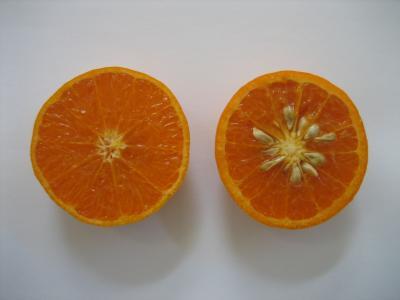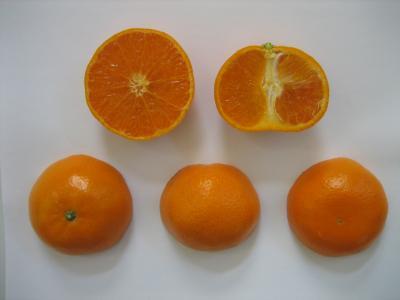RIVERSIDE, Calif. – Juicy. Extremely Sweet. Visually attractive. Easy to peel. Low seeded. These are the fine qualities that mark 'KinnowLS,' the latest citrus variety released by researchers at the University of California, Riverside.
Large-sized for a mandarin, the fruit has an orange rind color. The rind is thin and extremely smooth. The 10-11 segments in each fruit are fleshy and deep orange in color.
'KinnowLS' (the LS is short for low seeded) is a mandarin selection developed by mutation breeding of the mandarin cultivar 'Kinnow,' a mid-to-late season maturing variety developed by UC Riverside nearly 100 years ago. While 'Kinnow' has 15-30 seeds per fruit, 'KinnowLS' has only 2-3 seeds per fruit. Rarely, individual 'KinnowLS' fruit may have 4-7 seeds.
"People who like very sweet fruit are going to find 'KinnowLS' to be very appealing," said Mikeal Roose, a professor of genetics in, and chair of, the Department of Botany and Plant Sciences, who developed 'KinnowLS' along with staff scientist Timothy Williams. "When other citrus varieties mature to reach the level of sweetness of 'KinnowLS,' their other qualities – such as rind texture – are in decline. Neither 'Kinnow' nor 'KinnowLS' suffer in this way."

Photo compares the 'KinnowLS' (left) with 'Kinnow.' While "Kinnow" has 15-30 seeds per fruit, "KinnowLS" has only 2-3 seeds per fruit. Rarely, individual "KinnowLS" fruit may have 4-7 seeds.
(Photo Credit: T. Williams, UC Riverside.)
Yet another attractive quality of 'KinnowLS' is that it can be grown in California's desert regions because the fruit, which matures during February through April, does well in hot climates.
'Kinnow' is the most important mandarin in the Punjab regions of India and Pakistan, where 'Kinnow' fruit trees constitute about 80 percent of all citrus trees.
"But the fruit, which is popular there, is seedy," Roose said. "Therefore, 'KinnowLS' has very good potential in this area of the world."
Growers in India and Pakistan will have to wait a few years, however, before 'KinnowLS' trees can strike roots there. Currently, plans are to distribute 'KinnowLS' budwood, starting June 2011, to only licensed nurseries in California. (In November 2010, UCR distributed a few trees to a handful of California nurseries for the sole purpose of creating a bigger budwood supply.) For three years, only California nurseries will be permitted to propagate 'KinnowLS.' Licenses for 'KinnowLS' propagation outside the United States will be issued thereafter.
'KinnowLS' will not arrive in U.S. produce aisles for at least five years.
"It generally takes about that long to propagate citrus trees," Roose said.
Citrus is grown by 'budding,' not by planting a seed. This is because trees grown from a citrus seed are often quite different from the mother tree and the trees may be fruitless for many years. To circumvent these problems, growers and researchers grow seedlings from citrus seeds and then tightly splice onto their rootstock seedling a small amount of material, called a bud, from a tree of the desired variety.
When a new variety is released, citrus nurseries get a few buds from which they make "mother" trees. Buds from these trees make many "increase" trees, and then buds from the increase trees are used to make the trees sold to growers.
"These cycles take time," Roose said. "After the grower plants trees, they do not have much fruit until the third year after planting."
Mutation breeding is a technique commonly used by plant scientists to produce useful and desired traits in crops – e.g., larger seeds, new colors, or sweeter fruits – that either cannot be found in nature or have been lost during evolution. The mutations – changes in the structure of genes – are artificially induced by treatment with certain physical or chemical agents. In nature, spontaneous mutations, which are mutations that occur naturally, occasionally take place; mutation breeding can speed this up.
Currently, UCR has 12 'KinnowLS' trees. Six other locations in California each have a dozen 'KinnowLS' trees also.

This photo shows "KinnowLS," developed by researchers at UC Riverside.
(Photo Credit: T. Williams, UC Riverside.)